Effect of Sulfur-Containing Primers for Noble Metals on the Bond Strength of Self-Cured Acrylic Resin
Abstract
:1. Introduction
2. Materials and Methods
2.1. Preparation of Bonding Specimens
2.2. Shear Testing Procedure
2.3. Statistical Analysis
2.4. X-Ray Photoelectron Spectroscopy (XPS)
3. Results
4. Discussion
5. Conclusions
Conflicts of Interest
References
- Tanaka, T.; Nagata, K.; Takeyama, M.; Atsuta, M.; Nakabayashi, N.; Masuhara, E. 4-META opaque resin—A new resin strongly adhesive to nickel-chromium alloy. J. Dent. Res. 1981, 60, 1697–1706. [Google Scholar] [CrossRef] [PubMed]
- Yamashita, A.; Kondo, Y.; Fujita, M. Adhesive strength of adhesive resin PANAVIA EX to dental alloys. Part 2. Adhesive strength of precious alloys. J. Jpn. Prosthodont. Soc. 1984, 28, 1023–1033. [Google Scholar] [CrossRef]
- Watanabe, F.; Powers, J.M.; Lorey, R.E. In Vitro bonding of prosthodontic adhesives to dental alloys. J. Dent. Res. 1988, 67, 479–483. [Google Scholar] [CrossRef] [PubMed]
- Imbery, T.A.; Davis, R.D. Evaluation of tin plating systems for a high-noble alloy. Int. J. Prosthodont. 1993, 6, 55–59. [Google Scholar] [PubMed]
- Gates, W.D.; Diaz-Arnold, A.M.; Aqilino, S.A.; Ryther, J.S. Comparison of the adhesive strength of a BIS-GMA cement to tin-plated and non-tin-plated alloys. J. Prosthet. Dent. 1993, 69, 12–16. [Google Scholar] [CrossRef]
- Rubo, J.H.; Pegoraro, L.F.; Ferreira, P.M. A comparison of tensile bond strengths of resin-retained prostheses made using five alloys. Int. J. Prosthodont. 1996, 9, 277–281. [Google Scholar] [PubMed]
- Swartz, J.M.; Davis, R.D.; Overton, J.D. Tensile bond strength of resin-modified glass-ionomer cement to microabraded and silica-coated or tin-plated high noble ceramic alloy. J. Prosthodont. 2000, 9, 195–200. [Google Scholar] [CrossRef] [PubMed]
- Tanaka, T.; Atsuta, M.; Nakabayashi, N.; Masuhara, E. Surface treatment of gold alloys for adhesion. J. Prosthet. Dent. 1988, 60, 271–279. [Google Scholar] [CrossRef]
- Ohno, H.; Araki, Y.; Endo, K. A new method for promoting adhesion between precious metal alloys and dental adhesives. J. Dent. Res. 1992, 71, 1326–1331. [Google Scholar] [CrossRef] [PubMed]
- Stokholm, R.; Isidor, F.; Ravnholt, G. Tensile bond strength of resin luting cement to a porcelain-fusing noble alloy. Int. J. Prosthodont. 1996, 9, 323–330. [Google Scholar]
- Mori, K.; Nakamura, Y. Study on triazine thiols. V. Polymerization of 6-(4-vinylbenzyl propyl) amino-1,3,5-triazine-2,4-dithiol on copper plates and their corrosion resitance. J. Polym. Sci. Polym. Lett. Ed. 1983, 21, 889–895. [Google Scholar] [CrossRef]
- Kojima, K. Studies on adhesion of functional monomers with SH group to tooth substrates and dental alloys. J. Jpn. Soc. Dent. Mater. Devices 1986, 5, 92–105. [Google Scholar]
- Kojima, K.; Kadoma, Y.; Imai, Y. Adhesion to precious metals utilizing triazine dithione derivative monomer. J. Jpn. Soc. Dent. Mater. Devices 1987, 6, 702–707. [Google Scholar]
- Taira, Y.; Imai, Y. Primer for bonding resin to metal. Dent. Mater. 1995, 11, 2–6. [Google Scholar] [CrossRef]
- Yoshida, K.; Kamada, K.; Tanagawa, M.; Atsuta, M. Shear bond strengths of three resin cements used with three adhesive primers for metal. J. Prosthet. Dent. 1996, 75, 254–261. [Google Scholar] [CrossRef]
- Yoshida, K.; Kamada, K.; Sawase, T.; Atsuta, M. Effect of three adhesive primers for a noble metal on the shear bond strength of three resin cements. J. Oral Rehabil. 2001, 28, 14–19. [Google Scholar] [CrossRef] [PubMed]
- Taira, Y.; Kamada, K. Effects of primers containing sulfur and phosphate monomers on bonding type IV gold alloy. J. Dent. 2008, 36, 595–599. [Google Scholar] [CrossRef] [PubMed]
- Ikemura, K.; Fujii, T.; Negoro, N.; Endo, T.; Kadoma, Y. Design of a new metal primer containing a dithiooctanoate monomer and a phosphoric acid monomer for bonding prosthetic light-curing resin composite to gold, dental precious and non-precious metal alloys. Dent. Mater. J. 2011, 30, 300–307. [Google Scholar] [CrossRef] [PubMed]
- Choo, S.-S.; Huh, Y.-H.; Cho, L.-R.; Park, C.-J. Effect of metal primers and tarnish treatment on bonding between dental alloys and veneer resin. J. Adv. Prosthodont. 2015, 7, 392–399. [Google Scholar] [CrossRef] [PubMed]
- Piva, E.; Azevedo, E.C.; Ogliari, A.O.; Pilownic, K.J.; Pinto, M.B.; Camacho, G.B.; Petzhold, C.L.; Ogliari, F.A. Evaluation of experimental phosphate and sulfur-based primer bonding to metal casting alloys. Int. J. Adhes. Adhes. 2015, 58, 59–62. [Google Scholar] [CrossRef]
- Ikemura, K.; Endo, T.; Kadoma, Y. A review of the developments of multi-purpose primers and adhesives comprising novel dithiooctanoate monomers and phosphoric acid monomers. Dent. Mater. J. 2012, 31, 1–25. [Google Scholar] [CrossRef] [PubMed]
- Della Bona, A.; Anusavice, K.J.; Hood, J.A. Effect of ceramic surface treatment on tensile bond strength to a resin cement. Int. J. Prosthodont. 2002, 15, 248–253. [Google Scholar] [PubMed]
- Van Noort, R.; Noroozi, S.; Howard, I.C.; Cardew, G. A critique of bond strength measurements. J. Dent. 1989, 17, 61–67. [Google Scholar] [CrossRef]
- Morresi, A.L.; D’Amario, M.; Capogreco, M.; Gatto, R.; Marzo, G.; D’Arcangelo, C.; Monaco, A. Thermal cycling for restorative materials: Does a standard protocol exist in laboratory testing? A literature review. J. Mech. Behav. Biomed. Mater. 2014, 29, 295–308. [Google Scholar] [CrossRef] [PubMed]
- Gale, M.S.; Darvell, B.W. Thermal cycling procedures for laboratory testing of dental restorations. J. Dent. 1999, 27, 89–99. [Google Scholar] [CrossRef]
- International Standard Organization. Guidance on Testing of Adhesion to Tooth Structure. ISO/TR 11405 Dental Materials; ISO: Geneva, Switzerland, 1994; pp. 1–14. [Google Scholar]
- Kamada, K.; Tanaka, T.; Watanabe, I.; Uematsu, R.; Tanagawa, M.; Yoshida, K.; Matsumura, H.; Atsuta, M. Temperature change on the interface of adhesive retained prosthesis when taking foods. J. Jpn. Soc. Dent. Mater. Devices 1995, 14, 578–583. [Google Scholar]
- Okuya, N.; Minami, H.; Kurashige, H.; Murahara, S.; Suzuki, S.; Tanaka, T. Effects of metal primers on bonding of adhesive resin cement to noble alloys for porcelain fusing. Dent. Mater. J. 2010, 29, 177–187. [Google Scholar] [CrossRef] [PubMed]
- Kadoma, Y.; Kojima, K.; Tamaki, Y.; Nomura, Y. Water durability of resin bond to pure gold treated with various adhesion promoting thiirane monomers. Dent. Mater. J. 2007, 26, 29–37. [Google Scholar] [CrossRef] [PubMed]
- Suzuki, M.; Yamamoto, M.; Fujishima, A.; Miyazaki, T.; Hisamitsu, H.; Kojima, K.; Kadoma, Y. Raman and IR studies on absorption behavior of adhesive monomers in a metal primer for Au, Ag, Cu and Cr surfaces. J. Biomed. Mater. Res. 2002, 62, 37–45. [Google Scholar] [CrossRef] [PubMed]
- Echizenya, T. Interfaces of Metals and 4-META/MMA-TBBO resin. J. Jpn. Soc. Dent. Mater. Devices 1992, 11, 628–641. [Google Scholar]
- Ohno, H.; Araki, Y.; Segara, M. The adhesion mechanism of dental adhesive resin to the alloy-Relationship between Co-Cr alloy surface structure analyzed by ESCA and bonding strength of adhesive resin. Dent. Mater. J. 1986, 5, 46–65. [Google Scholar] [CrossRef] [PubMed]
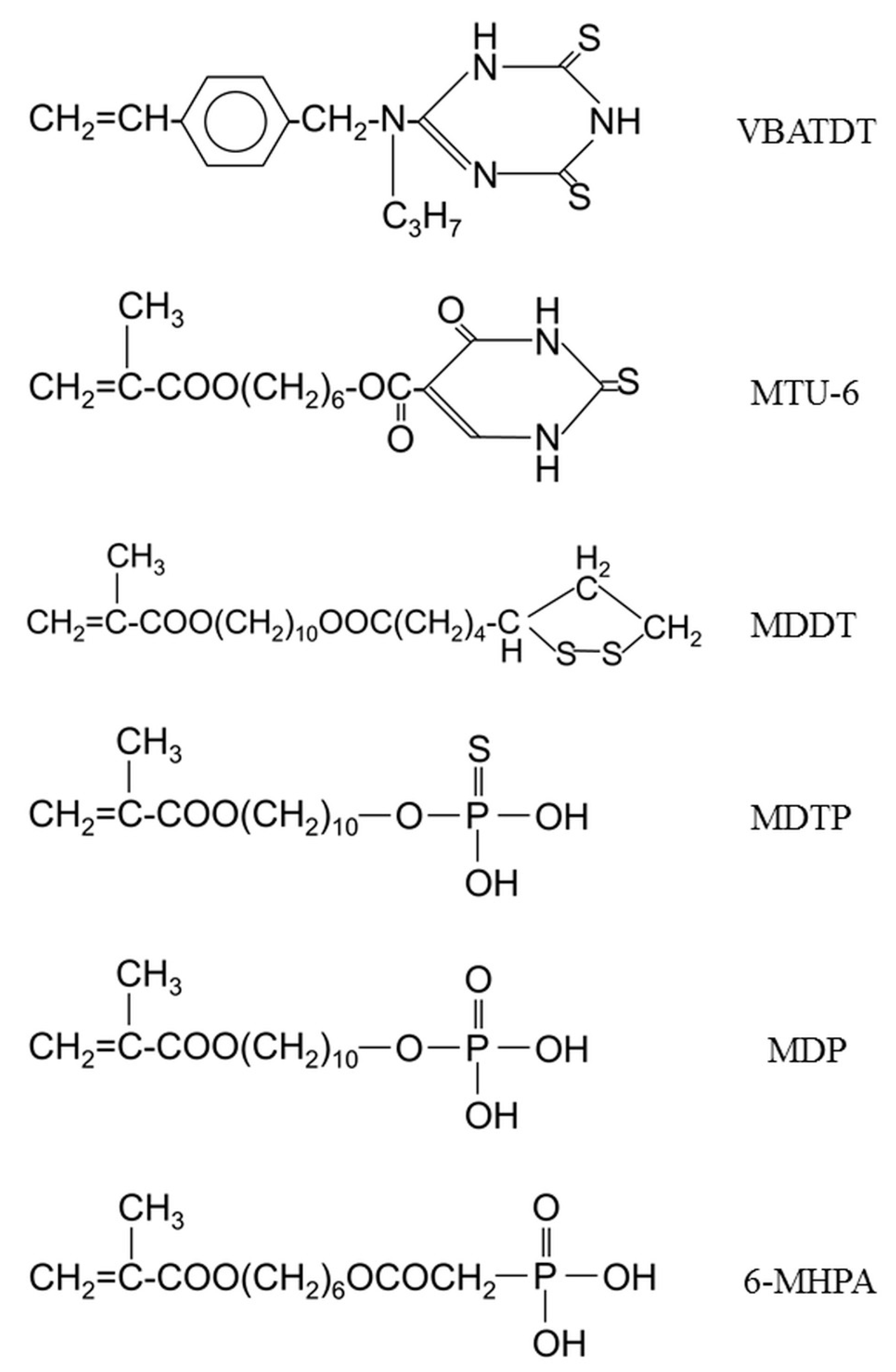
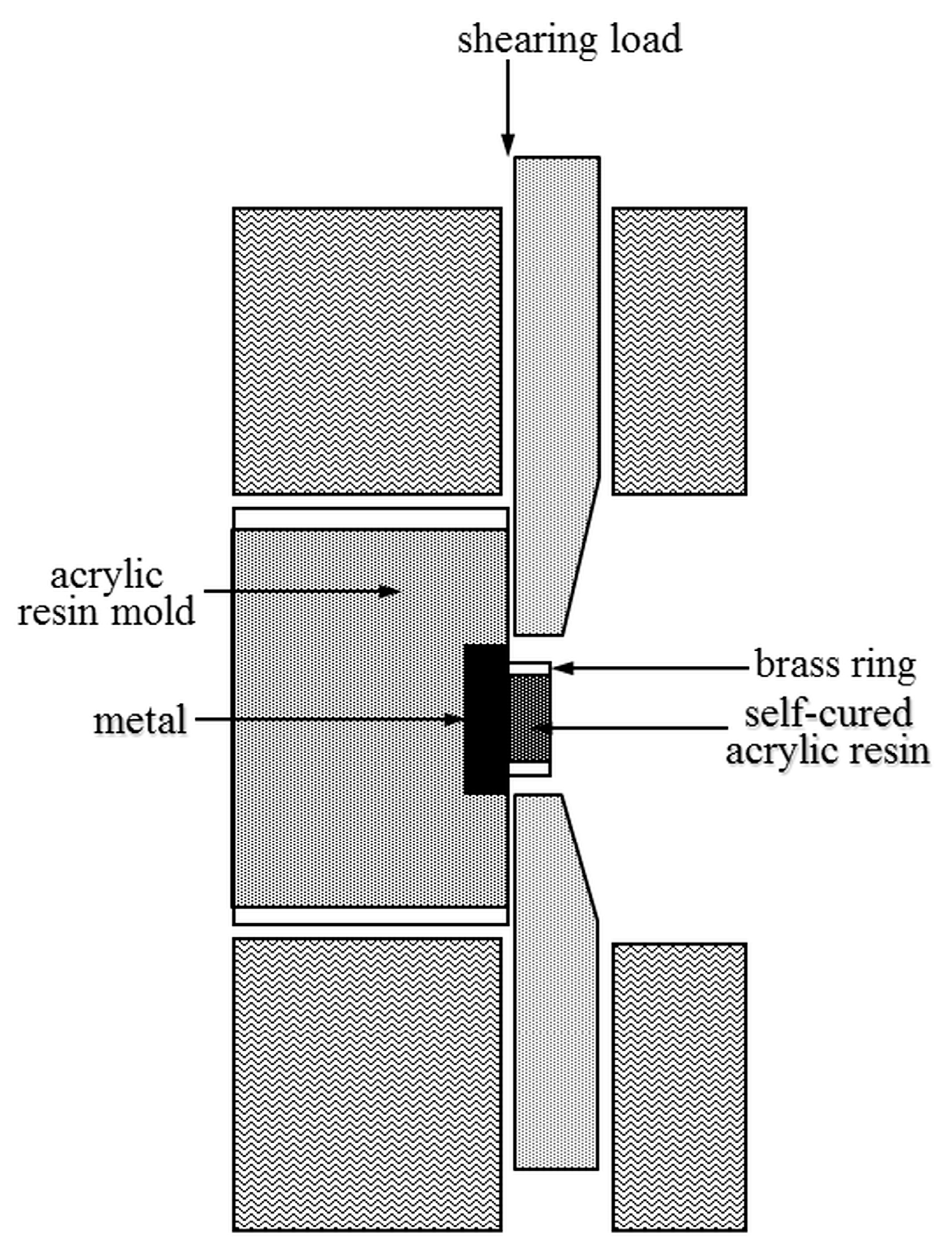
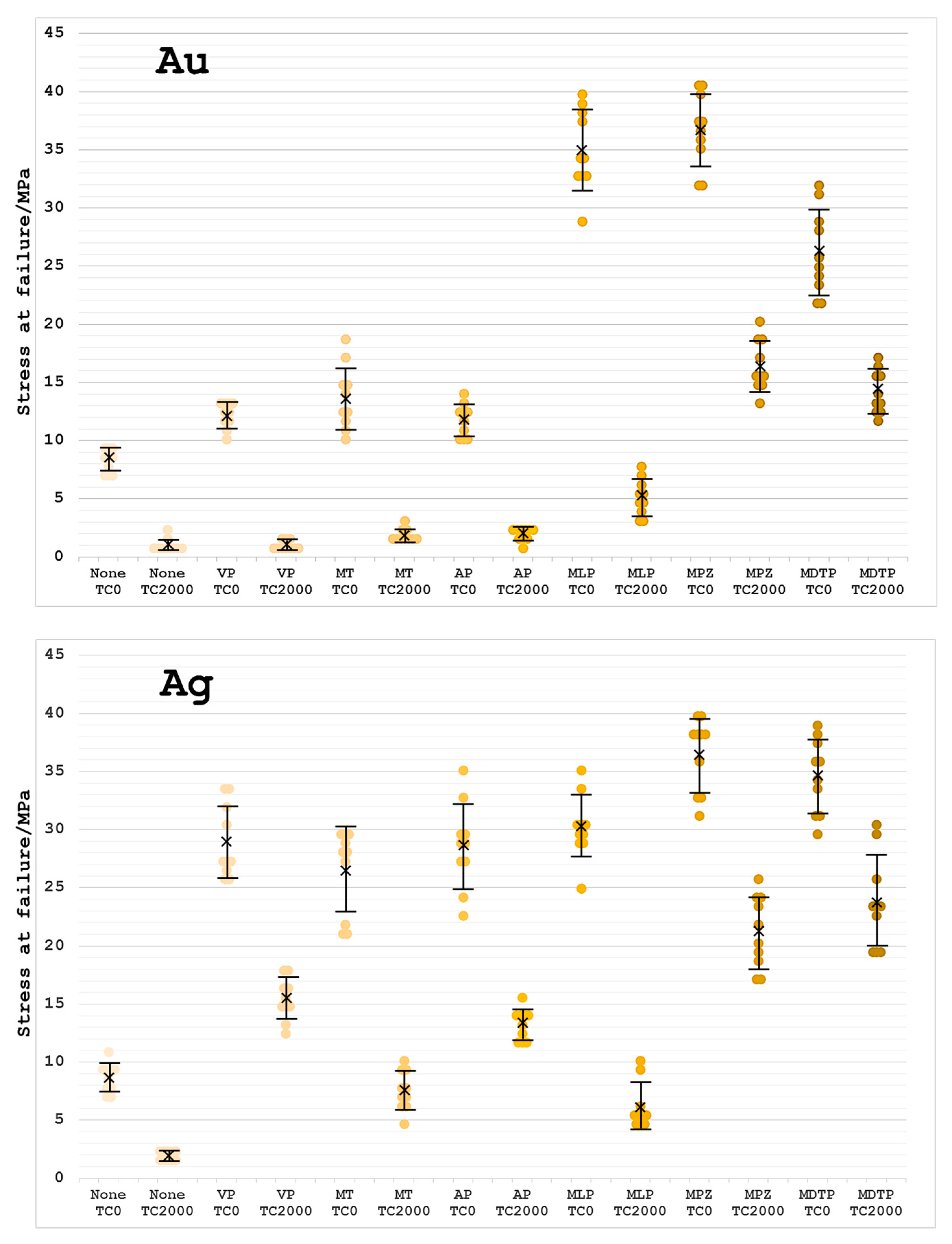

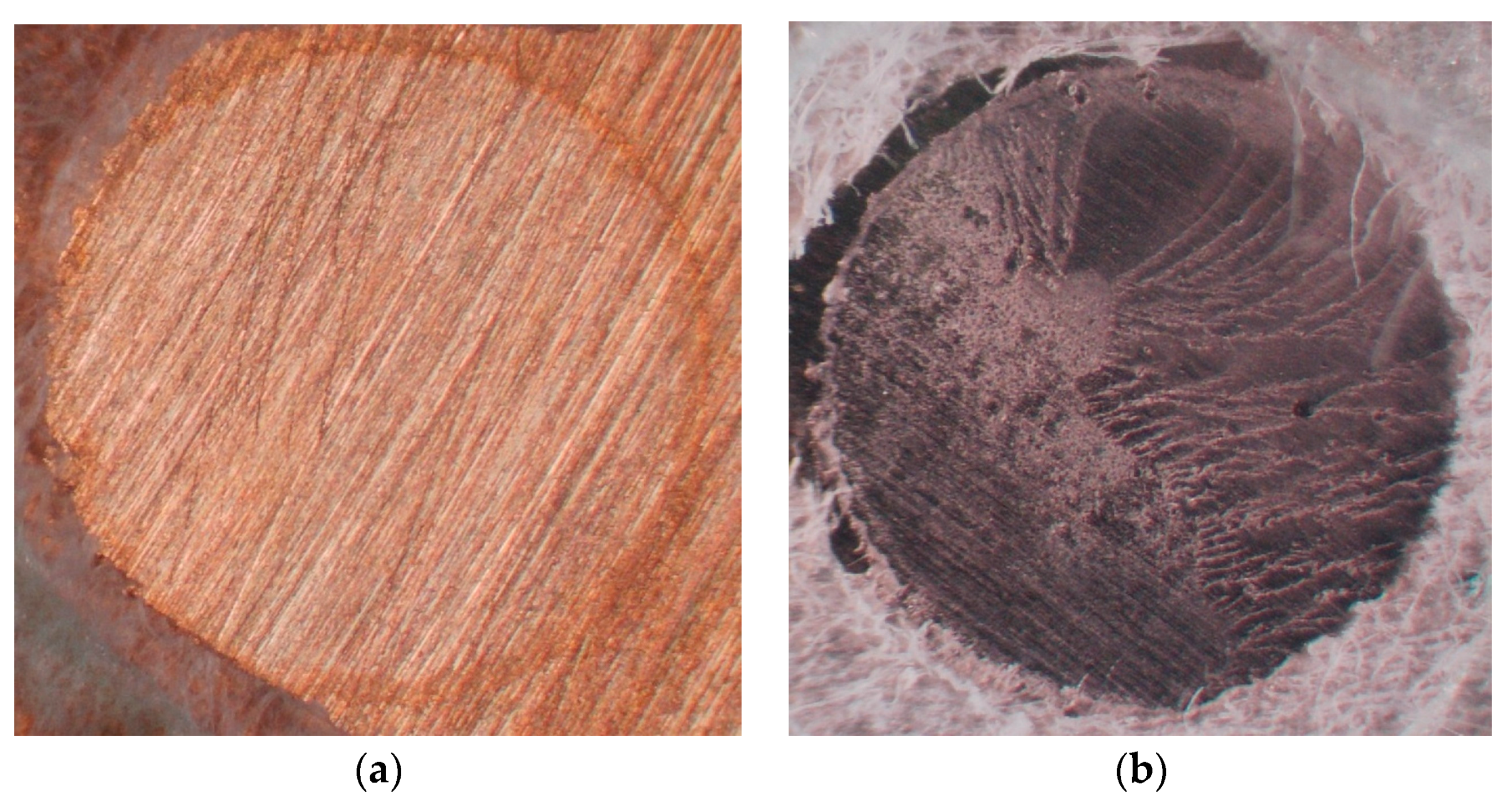
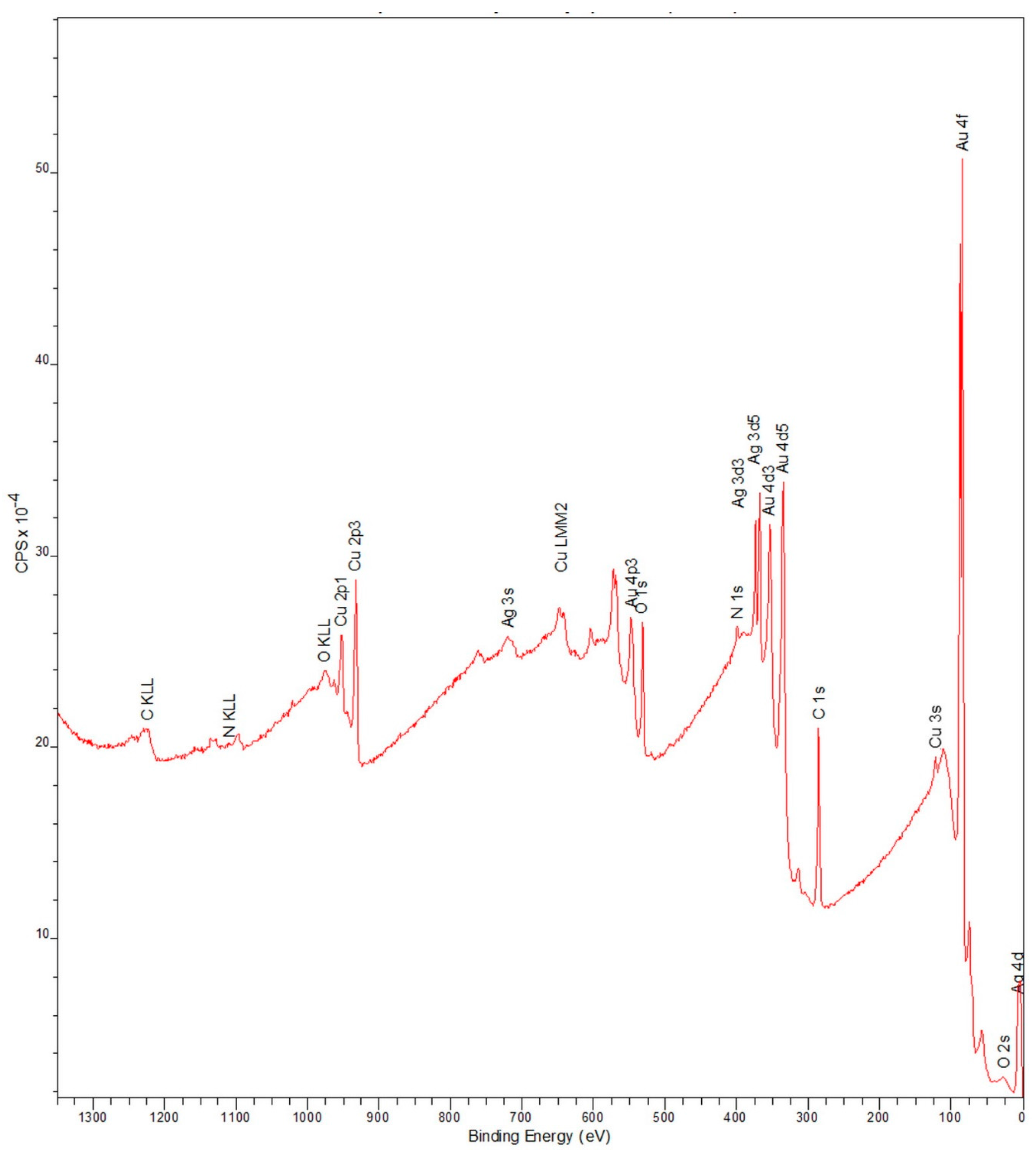
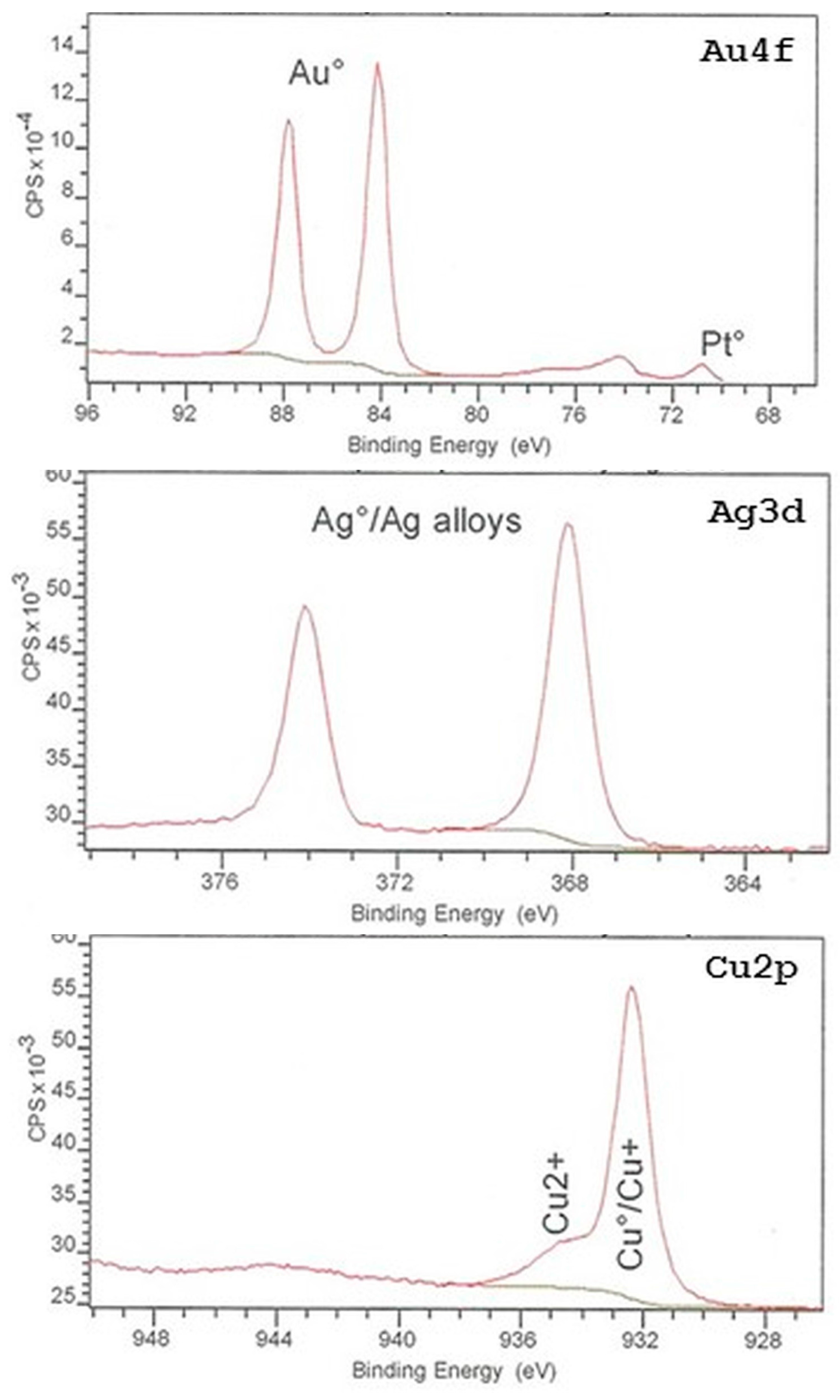
| Material | Manufacturer | Batch Number | Component | Code |
|---|---|---|---|---|
| Pure gold | High Purity Chemicals, Itado, Japan | 4148021 | Au > 99.99 | Au |
| Pure silver | High Purity Chemicals, Itado, Japan | 4124692 | Ag > 99.99 | Ag |
| Pure copper | High Purity Chemicals, Itado, Japan | 4124691 | Cu > 99.99 | Cu |
| Pure palladium | High Purity Chemicals, Itado, Japan | 4124693 | Pd > 99.99 | Pd |
| Casting gold M.C. Type IV | GC Corp., Tokyo, Japan | 141071 | Au70, Cu16, Ag8, Pd3, Pt2, Zn, Ir1 | Type IV Au alloy |
| V-Primer | Sun Medical, Moriyama, Japan | KT1 | VBATDT, acetone | VP |
| Metaltite | Tokuyama Dental Corp., Kamisu, Japan | 03182 | MTU-6, ethanol | MT |
| Alloy Primer | Kuraray Noritake Dental, Tainai, Japan | 7E0054 | VBATDT, MDP, acetone | AP |
| Metal Link Primer | Shofu Inc., Kyoto, Japan | 101482 | MDDT, 6-MHPA, acetone | MLP |
| Metal Primer Z | GC Corp., Tokyo, Japan | 1509101 | MDTP, MDP, ethanol | MPZ |
| MDTP | GC Corp., Tokyo, Japan | 1510282 | MDTP, ethanol | MDTP |
| Unifast III | GC Corp., Tokyo, Japan | 1506262 | Powder: polymethyl methacrylate, ethyl-methyl copolymer, barbituric acid derivative, acethylacetone copper | |
| 1403041 | Liquid: methylmethacrylate, ethyleneglycol dimethacrylate, dimethyl ammonium chloride |
| Source | Sum of Squares | df | Mean Square | F | p |
|---|---|---|---|---|---|
| Noble Metal (A) | 188.4872 | 4 | 47.1218 | 655.1361 | <0.0001 |
| Metal primer (B) | 382.1956 | 6 | 63.6993 | 899.1314 | <0.0001 |
| Thermal cycling (C) | 867.3237 | 1 | 867.3237 | 12,242.4948 | <0.0001 |
| A × B | 260.1635 | 24 | 10.8401 | 153.0114 | <0.0001 |
| A × C | 10.3560 | 4 | 2.5890 | 36.5445 | <0.0001 |
| B × C | 26.1581 | 6 | 4.3597 | 61.5381 | <0.0001 |
| A × B × C | 32.4949 | 24 | 1.3540 | 19.1114 | <0.0001 |
| Error | 44.6326 | 630 | 0.0708 | ||
| Total | 1811.8116 | 699 |
| Primer | Metal | Au | Ag | Cu | Pd | Type IV Au Alloy | |||||
|---|---|---|---|---|---|---|---|---|---|---|---|
| Cycles | 0 | 2000 | 0 | 2000 | 0 | 2000 | 0 | 2000 | 0 | 2000 | |
| None | 8.3 | 1.0 | 8.7 | 2.0 | 9.1 | 2.1 | 9.2 | 2.0 | 7.6 | 1.4 | |
| (1.0) a,A | (0.5) a,A | (1.2) a,A | (0.4) a,B | (1.5) a,A | (0.5) a,B | (1.5) a,A | (0.7) ab,B | (1.3) a,A | (0.6) a,AB | ||
| VP | 12.2 | 1.0 | 28.9 | 15.4 | 17.2 | 8.9 | 13.7 | 1.3 | 13.1 | 1.9 | |
| (1.1) b,A | (0.4) a,A | (3.1) b,C | (1.8) c,C | (2.2) b,B | (1.6) c,B | (1.2) b,A | (0.5) a,A | (2.7) b,A | (1.0) a,A | ||
| MT | 13.7 | 1.9 | 26.5 | 7.6 | 23.2 | 8.7 | 15.1 | 2.0 | 20.7 | 1.7 | |
| (2.7) b,A | (0.5) a,A | (3.7) b,C | (1.7) b,B | (2.6) c,B | (1.1) c,B | (2.4) b,A | (0.7) ab,A | (1.9) c,B | (0.7) a,A | ||
| AP | 11.8 | 2.0 | 28.6 | 13.3 | 25.5 | 6.2 | 13.3 | 1.7 | 10.5 | 1.3 | |
| (1.4) b,A | (0.6) a,A | (3.7) b,C | (1.3) c,C | (2.3) c,B | (2.1) b,B | (1.2) b,A | (0.6) ab,A | (1.3) b,A | (0.5) a,A | ||
| MLP | 35.0 | 5.1 | 30.2 | 6.2 | 34.9 | 8.7 | 18.1 | 3.8 | 41.0 | 10.4 | |
| (3.5) d,C | (1.6) b,AB | (2.7) b,B | (2.0) b,B | (2.9) d,C | (2.2) c,C | (2.5) c,A | (0.9) c,A | (3.7) d,D | (2.2) b,C | ||
| MPZ | 36.7 | 16.5 | 36.5 | 21.2 | 31.7 | 9.2 | 19.3 | 2.3 | 39.5 | 16.7 | |
| (3.1) d,C | (2.2) c,C | (3.2) c,C | (3.1) d,D | (3.0) d,B | (1.8) c,B | (2.4) c,A | (0.6) b,A | (3.1) d,C | (1.7) c,C | ||
| MDTP | 26.2 | 14.2 | 34.6 | 23.7 | 17.9 | 3.3 | 18.4 | 2.4 | 37.5 | 10.9 | |
| (3.7) c,B | (1.9) c,C | (3.2) c,C | (3.9) d,D | (1.5) b,A | (0.7) a,A | (1.7) c,A | (0.6) b,A | (4.3) d,C | (1.2) b,B | ||
| Primer | Metal | Au | Ag | Cu | Pd | Type IV Au Alloy | |||||
|---|---|---|---|---|---|---|---|---|---|---|---|
| Cycles | 0 | 2000 | 0 | 2000 | 0 | 2000 | 0 | 2000 | 0 | 2000 | |
| None | A10 | A10 | A10 | A10 | A10 | A10 | A10 | A10 | A10 | A10 | |
| VP | M10 | A10 | M10 | M10 | M10 | A10 | M10 | A10 | M10 | A10 | |
| MT | M10 | A10 | M10 | A10 | M10 | A10 | M10 | A10 | M10 | A10 | |
| AP | M10 | A10 | M10 | M10 | M10 | A10 | M10 | A10 | M10 | A10 | |
| MLP | M10 | A10 | M10 | A10 | M10 | A10 | M10 | A10 | M10 | M10 | |
| MPZ | M10 | M10 | M10 | M10 | M10 | A10 | M10 | A10 | M10 | M10 | |
| MDTP | M10 | M10 | M10 | M10 | M10 | A10 | M10 | A10 | M10 | M10 | |
© 2017 by the author. Licensee MDPI, Basel, Switzerland. This article is an open access article distributed under the terms and conditions of the Creative Commons Attribution (CC BY) license (http://creativecommons.org/licenses/by/4.0/).
Share and Cite
Yoshida, K. Effect of Sulfur-Containing Primers for Noble Metals on the Bond Strength of Self-Cured Acrylic Resin. Dent. J. 2017, 5, 22. https://doi.org/10.3390/dj5020022
Yoshida K. Effect of Sulfur-Containing Primers for Noble Metals on the Bond Strength of Self-Cured Acrylic Resin. Dentistry Journal. 2017; 5(2):22. https://doi.org/10.3390/dj5020022
Chicago/Turabian StyleYoshida, Keiichi. 2017. "Effect of Sulfur-Containing Primers for Noble Metals on the Bond Strength of Self-Cured Acrylic Resin" Dentistry Journal 5, no. 2: 22. https://doi.org/10.3390/dj5020022




